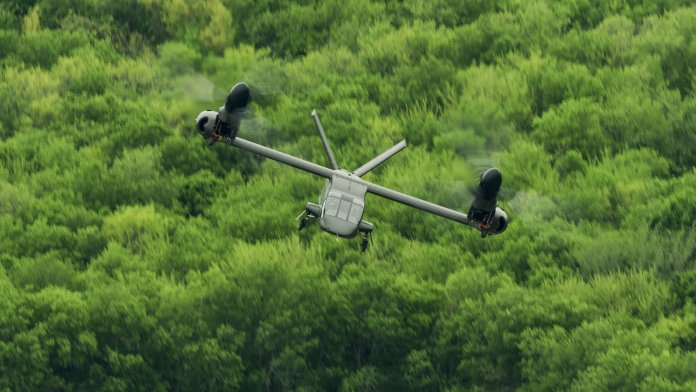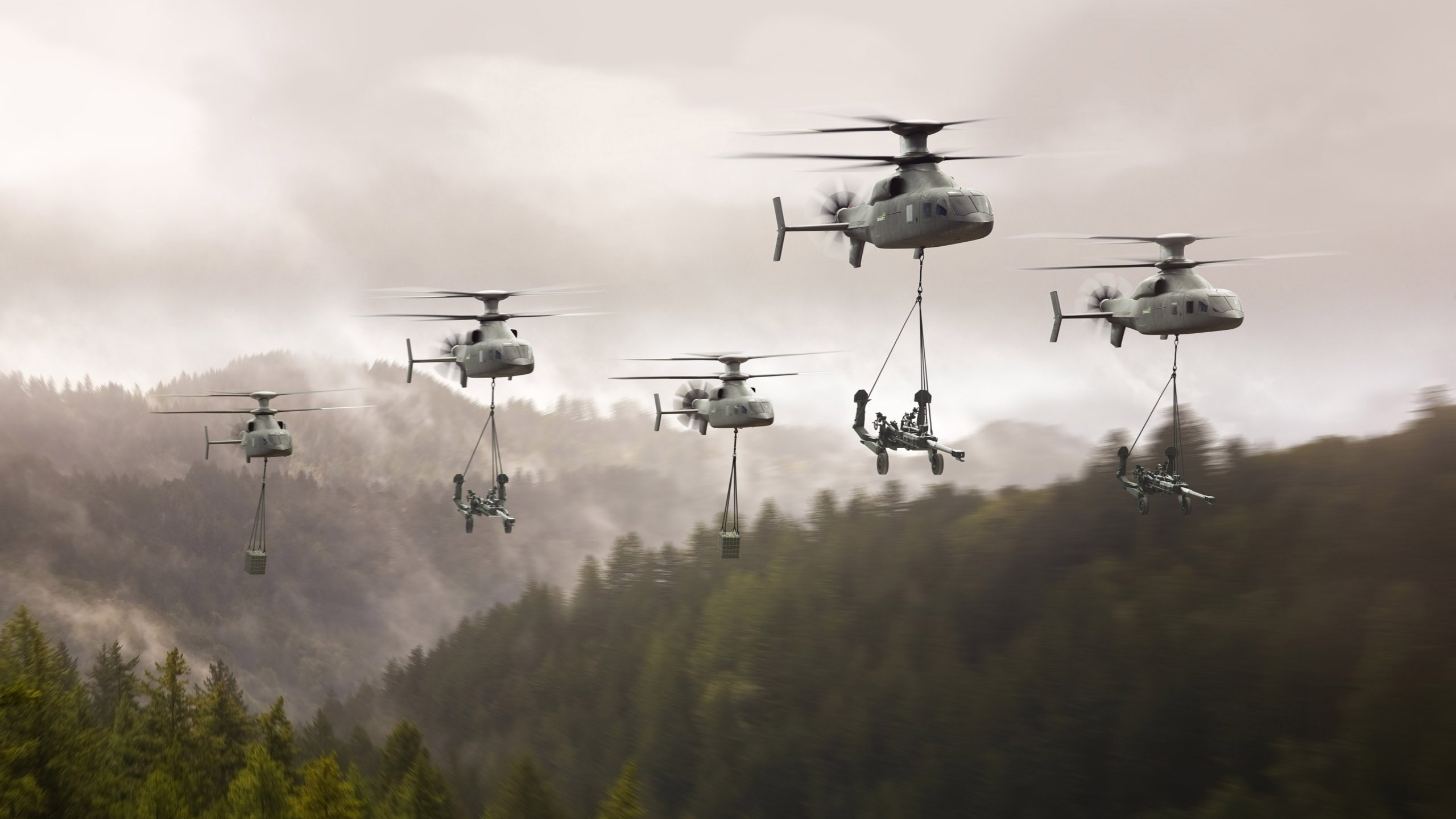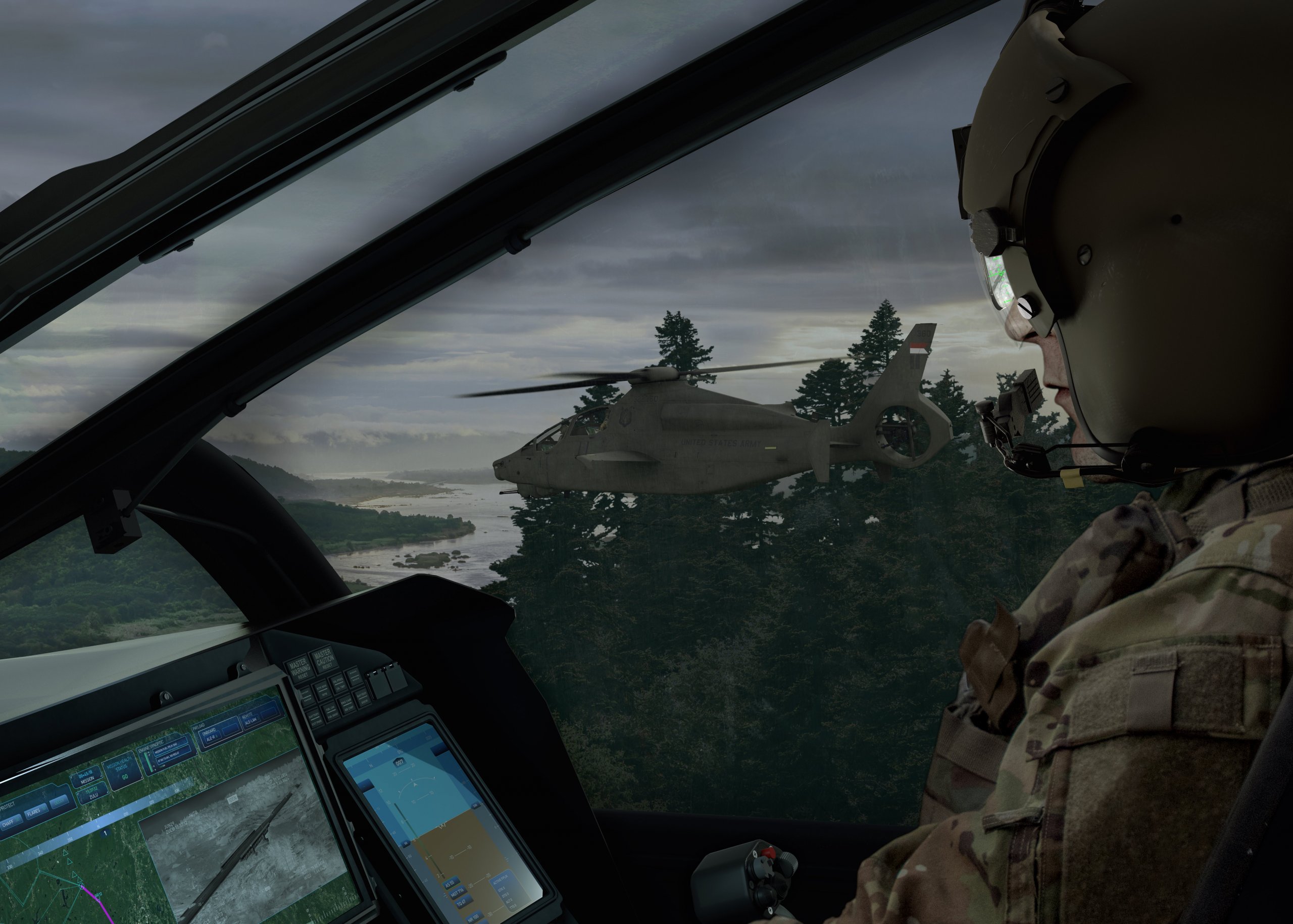
The US Army is on track to ensure that the two platforms that emerge from the Future Vertical Lift concept – FLRAA and FARA – will be the best prepared and most capable when they are delivered to their first unit equipped around 2030.
“We have had major aviation capability gaps for a while. We have tried to modernise at the same time as being engaged in major combat operations, but we are now focused on peer and near-peer competitors,” said Matthew Isaacson, chief of operations, Signature Modernisation Effort Integration Lead, US Army, speaking on 11 May at the Vertical Flight Society (VFS) forum on Future Vertical Lift (FVL).
The return to ‘peer’ type competition means has led to a number of significant changes away from the counter-insurgency (COIN) stance that has characterised the last couple of decades. With an opponent now capable of creating Anti Access/Area Denial (A2AD) areas, there is a requirement for new rotorcraft in particular to have greater reach and standoff performance in multi-domain operations.
While Isaacson confirmed that the Army’s legacy rotorcraft – the Boeing AH-64 Apache, Sikorsky UH-60 Black Hawk and Boeing CH-47 Chinook – will remain in front line service for some decades and potentially until the 2060s for the last aircraft in the fleet, FVL is the ultimate priority.
The US Army has devoted time and resources into getting its next generation aircraft right. It has engaged with industry and pushing forward from the concept of creating Joint Multi Role Technology Demonstrators (JMR TD), it has crystalised its view onto two specific platform types: the Future Long-Range Assault Aircraft (FLRAA) and the Future Attack Reconnaissance Aircraft (FARA).
The benefit of this extended development process, which in no small way required industry to reach deeply into its own pockets, has seemingly resulted in a steady focus on what is fundamentally required, without the diversions of mission creep that proved so costly to historical development programmes such as the Boeing-Sikorsky RAH-66 Comanche.
The major difference this time, said Isaacson, is that the Army’s prototyping regime has “shown that the core vehicle technology is enough for the Army to invest in, in ways we have not done before. Normally we wait until pre-Milestone C (the point at which production is initiated) to know if the core technology is there.” Milestone A is usually when technology maturation and risk reduction is initiated, while Milestone B triggers engineering and manufacturing development.

FLRAA
During a conflict against a more capable enemy than lightly armed fighters typical of a COIN operation, speed and range of manoeuvre may well be a critical factor, perhaps even to take advantage of a breach in the enemy’s A2AD defences.
“A lot of the Army’s manoeuvre capability is enabled by aviation,” said Colonel David Phillips, project manager, Program Executive Office FLARA, recalling how during Operation Desert Storm in 1991 three brigades of the 101st Airborne Division were moved up to 350 miles to block the Iraqi Republican Guard in 96 hours, one of the longest and largest air assaults to be attempted. Philips said that if you could take that requirement into today’s planning using FLRAA, it could be done in half the time at twice the distance.
“Coordination and collaboration is very important, and you will hear a lot about a Modular Open Systems Approach (MOSA), including between the new aircraft and the existing platforms,” said Philips.
For those who do not know the background to this programme, the downselected flying prototypes for the FLRAA programme comprise the Sikorsky-Boeing DefiantX, a compound co-axial rotorcraft, and the V-280 Valor tiltrotor from Bell. Both contenders have a history of development and designs around their particular platform design.
In terms of the status of the programme, Philips said that the competitive demonstration and risk reduction (CCDR) phase was executed from last year for a full year to “better understand the weapons systems designs and what the requirements should be for affordability, performance and schedule to 2030.”
“The second phase has brought the engineering down to the subsystem and baseline level,” he added. The Army is looking at both designs and how they will continue to mature through a ‘digital thread’. By using model based systems engineering,
The FLRAA development timeline will see a final Request for Proposal (RfP) being issued in the second half of the year, a contract award during the summer 2022, a Milestone B in the fourth quarter of 2023 and a Milestone C decision around late 2027 or 2028. Fielding is still on track for 2030.
However, a virtual prototype is planned for 2024 before a physical prototype. “This will combine a virtual model and a portable crew station – we can plug it into the air manoeuvre battle lab and the common aviation brigade integration lab and with that we can start proving concepts for integration earlier in the programme earlier than if we were waiting for the physical aircraft to get into the training base and to operational units in 2030,” explained Philips. This will feed into the development of the physical aircraft resulting in the objectives of it being, affordable, sustainable and survivable being met by the time it is fielded. it will also give guidance regarding the sustainment of the type chosen in when out on operations in the field, back in the depot, and when it needs to be physically repaired.
In terms of the development of MOSA through the architecture working group, Philips said that the team had grown from 300-400 people to around 700-800 participants – with around 150 people at every meeting. “Smaller group meetings – component definition sub groups are contributing into the architecture framework which will eventually go into the RfP. With that, industry will have the most updated standards and architecture to build to. This should mean more mature technologies downstream allowing us to bring them on ‘at pace’ over time,” said Philips.
A statement sent to Armada International on behalf of the Sikorsky-Boeing team behind Defiant X pointed out that “Defiant X builds on the handling qualities and transformational capabilities proven in flight tests by our SB>1 Defiant technology demonstrator and is already undergoing testing and evaluation in a digital combat environment. The result is an adaptable design that delivers transformational speed, range and unprecedented manoeuvrability.”

It continued: “As we ramp up Competitive Demonstration and Risk Reduction (CD&RR) we will refine the final set of weapon system requirements and complete our preliminary design review. Supporting this review will be subsystem preliminary design reviews. The overarching objective of this phase of the programme is to enable the successful execution of detailed design following contract down-select.
Addressing comments made by Philips earlier, Boeing-Sikorsky will refine its virtual prototype “utilising a digital twin and digital design techniques” that the organisations are already using. This will help the Army not only to achieve lower acquisition “but enable rapid, affordable upgrades to stay ahead of the evolving threat. We will continue to sharpen our tools with data from flight test, our powered system test bed, end-to-end Systems Integration Lab (SIL), Sikorsky S-97 RAIDER flight test, and other risk reduction activities.”
The statement reveals that aircraft maintainers will “perform procedures at scale in virtual reality labs, sharing their perspective with designers on everything from ease of access, to ergonomics, to …the removal of parts for servicing.”
Bell too, is prepared to meet the Army’s RfP which it expects from this summer. In a statement released as this issue went to press, Bell stated that the 280 Valor “builds on the exemplary flight-test results and programmatic execution during the Joint Multi-Role Technology Demonstrator (JMR TD) program and Competitive Demonstration and Risk Reduction (CD&RR).
The statement revealed that the “V-280 Valor [had] marked the completion of its three-year flight-test program with a series of demonstrations to highlight its revolutionary performance during more than 214 hours of flight.”
The company added that its V-280 had “completed all planned Key Performance Parameters including low-speed agility, long-range cruise, 305 knot high-speed flights, and rapid mission systems integration” throughout the test.
The Army’s involvement had included five Army test pilots who were able to fly the V-280 over 15 sorties. The company also held a ‘Soldier Touchpoint’ event where pilots, mechanics had a chance to discuss their own requirements from the future FLRAA.
According to long-time expert on tiltrotor technology for Bell, Keith Flail, executive vice president, Advanced Vertical Lift Systems, commented: “We assessed several vertical lift technologies and determined the tiltrotor to be the only solution to the agility, range, and speed requirements of a long-range assault aircraft that can meet the cost, timeline, and risk profile required for a successful acquisition program.”
Bell will continue with CD&RR Phase II which should result in “preliminary designs for major subsystems and the conceptual weapons system, based on data-proven performance that ensures transformational capabilities will be delivered in line with the Army’s schedule.”
FARA
The contenders for the Future Attack Reconnaissance Aircraft (FARA) programme are once again Lockheed Martin Sikorsky with Raider X and Bell with its Invictus 360, a design based on its civil Bell 525 helicopter. This is not a tiltrotor.

Colonel Greg Fortier, project manager, FARA, also speaking at the VFS event in May, said that FARA was on the same development track as FLRAA with a Milestone B in 2024 and a target of first unit equipped in 2030. However, the later starting time for the FARA programme (in 2019) “was that they could leverage work already done by the Cross Functional Team (CFT) and JMR TD before it.
“We are aware the Army has tried this three times before [the Boeing–Sikorsky RAH-66 Comanche, Bell’s Armed Reconnaissance Helicopter ARH-70 Arapaho, and Armed Aerial Scout – multiple contenders], and we are doing this so much differently than before,” said Fortier. “We need to experiment, prototype and demonstrate a next generation air vehicle as quickly as we can. We have two roles: get the demonstrators flying by FY23 … and we are just south of halfway complete which is quite remarkable when you think contract was only awarded in FY19.”
“Not having the luxury of a competitive demonstration and risk reduction phase, we are somewhat overlapping them,” said Fortier. For the last 21 months the FARA team has been understanding the designs and their technical maturity, as well as understanding what adjustments need to be made towards the next iteration. This will feed into a draught RfP then full RfP to industry asking for flight data and weapons systems designs.
The rapid pace of the programme means that prototypes need to fly in FY23 to get into an EMD [engineering & manufacturing development] phase as quickly as possible to deliver in 2030. “We have a two year window to conclude the risk reduction activities outside of a formal competitive demonstration, but using events such as Project Convergence 20 and 21 (an ongoing campaign of learning that brings together new and developing technologies from across the Army) and also the specifically aviation focused EDGE 21 event (Experimental Demonstration Gateway Exercise) which was held at the Dugway Proving Ground, Utah. “We have been intertwined with the CFT, S&T partners to really understand the analysis and update the facts and assumptions. “We finished run-ups in March/April to get the A-CCD (Abbreviated – Capabilities Development Document) through the AROC (Army Requirements Oversight Committee) – validates the designs of the two proposed contenders – and got positive feedback,” said Fortier.
There is much to understand from industry which is mainly conducted through Requests for Information (RfIs): where the schedules and affordability points are. “Our main focus now is getting an Improved Turbine Engine mature enough to get into our prototypes; getting a gun fired on the ground and surrogate platforms, and test our modular effects launcher,” said Fortier.
“The MOSA discussions are now delving into where the symmetries are and we will be moving to another AROC next year so we will know more about the weapons systems designs and the mission system optimisation – all driving towards the down-select in FY24,” outlined Fortier.
Some of the requirements for FARA include a rotor disk no greater than 40 feet (12.1 metres) and max gross weight no more than 14,000lb (6,350kg). “We need range, endurance then endurance at range,” added Fortier. “We are driving industry to get the empty weight down as low as possible – we all know the lightest is will ever be is the first version.”
The roadmap ahead is that the ITEP engine is going through testing including software and hardware development with the first engine to test scheduled in the first quarter of 2022. After that engines will be sent to the industry teams for integration into their prototype. The schedule for first flight is in 2023. The weapons launched is being prototyped while the gun is undergoing reliability testing and will then go on to environmental testing and surrogate shooting at the next Project Convergence.

Lockheed Martin/Sikorsky says that it is continuing to build the RaiderX on the lessons learned from the S-97 Raider (its original concept for the Army’s aviation reconnaissance platform to replace the OH-58D Kiowa Warrior).
“Leveraging data from Raider’s flights has allowed our team to get ahead of schedule on our software builds while lowering cost and risk. Raider X has completed its detailed design phase and is currently in final assembly. There are over 200 parts being fabricated in Sikorsky’s state-of-the-art, digital production facility leveraging the approximately $600 million of capital investment the company has made over the past five years,” read the statement provided to Armada.
by Andrew Drwiega













